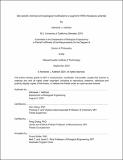Site-specific chemical and topological modifications to augment mRNA therapeutic potential
Author(s)
Aditham, Abhishek J.
DownloadThesis PDF (12.60Mb)
Advisor
Wang, Xiao
Zhang, Feng
Terms of use
Metadata
Show full item recordAbstract
Synthetic mRNA has emerged as a promising therapeutic platform for the treatment of a wide variety of diseases. Despite clinical demonstrations of mRNA for SARS-CoV-2 vaccines, mRNAs remain limited in application by their susceptibility to nucleases and overall short expression lifetime in vivo. We investigated the site-specific installation of chemical and topological modifications into therapeutic mRNA to augment their expression in cell cultures and mouse models. We began by developing messenger oligonucleotide-conjugated RNAs
(mocRNAs), which are mRNAs ligated to modified oligonucleotides that contain 3’ nuclease-resistant modifications. We show that mocRNAs are subject to slower deadenylation and enhance therapeutic protein expression in cell lines and primary cell cultures. We expanded on this technology by creating mRNAs with chemically branched poly(A) tails, or multitail mRNAs, which increase the density of modifications at the 3’ end of mocRNA and further stabilize mRNA against deadenylation.
In conjunction with increased nuclease resistance at the 3’ terminus, we developed a strategy to enhance translation initiation on circular mRNAs (circRNAs). We developed QRNAs, which are circRNAs that possess an unnaturally-linked inverted 7-methylguanosine (m7G) cap. QRNAs substantially outperform conventional circRNAs, given the low translation initiation efficiency of IRES compared to cap-dependent initiation. Ultimately, our studies exploring the chemical and topological space of mRNA demonstrates the value of site-specific chemical and topological modifications for designing future generations of designer mRNA-based therapeutics.
Date issued
2024-09Department
Massachusetts Institute of Technology. Department of Biological EngineeringPublisher
Massachusetts Institute of Technology